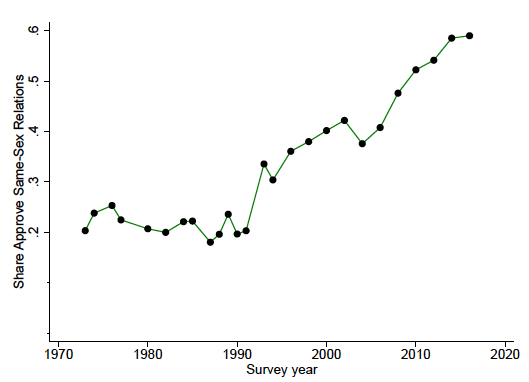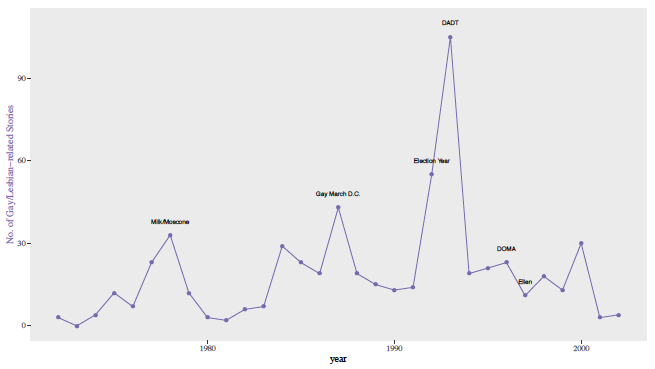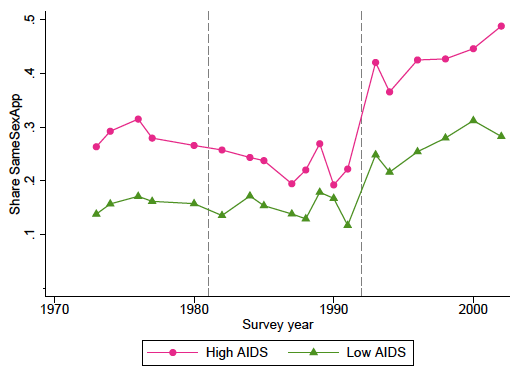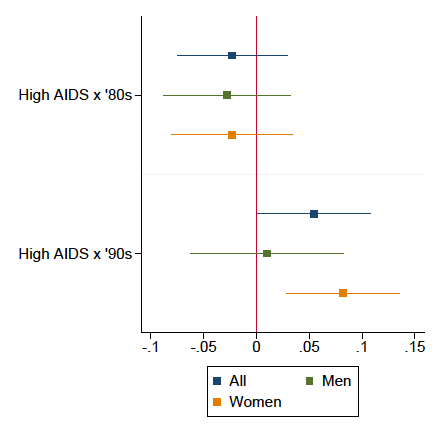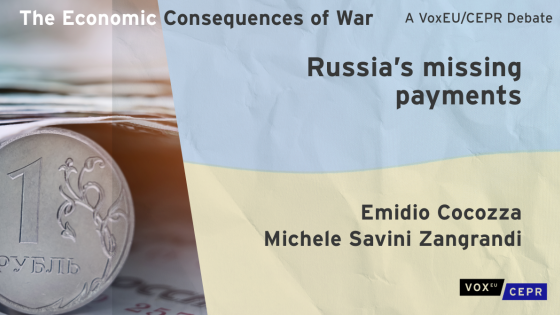Over the last few decades, there has been a large change in public opinion towards same-sex relationships in many countries. As shown in Figure 1, when asked whether it is “wrong for same-sex adults to have sexual relations”, in the early 1970s, only around 20% of Americans thought that it was never or almost never wrong (as opposed to almost always or always wrong). By 2016, the equivalent figure was around 60%. This is a vast cultural change. Why did this change take place?
Figure 1 Share of US population that answered “never wrong” or “sometimes wrong” to the question “Is it wrong for same-sex adults to have sexual relations?”, 1972 to 2016
Source: GSS.
Social beliefs are stable when the incentives for people to deviate in their public actions/beliefs are low, either because the individual reward from doing so is small or because the cost is relatively higher. Some sort of ‘shock’ is needed, either in the form of new knowledge/information that alters beliefs directly and/or in the form of a sufficiently large change in relative rewards that renders deviating from the norm desirable to significant numbers of people.
What shock could have changed people’s beliefs regarding the morality of same-sex relationships? Two recent studies (Aksoy et al. 2018, Adams and Waddell 2018) use cross-country and cross-US-state variation in timing to provide evidence that changes in laws that govern same-sex relationship recognition are associated with changes in public opinion.
In our recent paper (Fernández et al. 2019), we identify an earlier and powerful shock to public opinion: the AIDS epidemic. We argue and provide evidence that the AIDS epidemic changed the relative payoff for gay individuals to come out and mobilise by uniting behind a common cause. Although AIDS was a national (indeed international) epidemic, its intensity varied across US states. We hypothesise that the change in attitudes is greater in those states most exposed to the AIDS epidemic, where the latter itself is a proxy for a variety of factors such as the concentration of gay people, their visibility, local activism, and so on.
AIDS and institutions
Although the AIDS epidemic started in the US in 1981 and grew rapidly after that, a closer look at Figure 1 reveals that the change in opinion is discontinuous. Indeed, public opinion doesn’t change until around 1992, whereupon it jumps up sharply. The year 1992 was an important one in the US. In this electoral year, the two presidential candidates – George H W Bush and Bill Clinton – take sharply diverging views on gay-related issues, especially on the existing Pentagon ban on gay men serving in the military. This was reflected in the party platforms with the Republicans stating “Unlike the Democrat Party and its candidate, we support the continued exclusion of homosexuals from the military as a matter of good order and discipline.”1
The (endogenous) reaction of political parties reflects the competitive nature of party politics that is constantly seeking funds and votes. As expressed by Rahm Emanuel (the Clinton campaign’s then national finance director) “The gay community is the new Jewish community. It’s highly politicised, with fundamental health and civil rights concerns. And it contributes money. All that makes for a potent political force, indeed.’’2 As can be seen in Figure 2, this greater focus on gay-related issues was mirrored in the attention paid by the media. Gay-related issues went from being on one of the ‘big three’ TV news channels approximately once every 19-20 to appearing once every 3-4 days.
Figure 2 Evolution of the number of evening news stories (ABC, CBS, NBC) related to the gay community
Source: Vanderbilt News Archive; see Fernández et al. (2019) for more detail.
Electoral politics, however, are national events and thus might be expected to impact everyone in a similar fashion. We show that this is not the case. In response to a national debate that presumably motivated individuals to rethink their positions towards gay people, opinions reacted more precisely in those states with greater exposure to the AIDS epidemic (see Figure 3). This could be the result of a variety of correlated reasons such as greater interaction with gay people, being exposed to a more mobilised gay community, or having more gay friends.
Figure 3 Share of answers “never/only sometimes wrong” to the GSS question “Is it wrong for same-sex adults to have sexual relations?”
Notes: SameSexApp is a dummy variable that takes the value one if the individual responds “never wrong” or “sometimes wrong”. See Fernández et al. (2019) for definition of high- vs low-AIDS categories.
This relationship between AIDS and the subsequent change in opinion in the 1990s is shown rigorously in our difference-in-difference analysis. Differentiating across three time periods – prior to AIDS (the 1970s), during the AIDS epidemic but before the 1992 presidential election (the 1980s), and after the 1992 presidential election (the 1990s) – and across three groups of states according to their exposure to the AIDS epidemic (high, medium, and low), we show that states with high AIDS rates experienced a greater change in opinion precisely in the 1990s.3
The blue lines in Figure 4 graph the magnitude of the coefficients associated with the change in approval of same-sex relationships from residing in a high- vs low-AIDS state in the 1980s and the 1990s relative to the 1970s. As can be seen from the figure, living in a high-AIDS state in the 1990s is associated with an additional change in approval, relative to the change in low-AIDS states, of some 5.5 percentage points. Note that individuals who lived in low-AIDS states saw opinions change by 11 percentage points. Therefore, the analysis suggests that had they been exposed to higher levels of the AIDS epidemic, the approval share in those states would have been 50% greater.
Figure 4 Change in approval of same-sex relationships from residing in a high- vs low-AIDS state
AIDS and gender
Figure 5 shows that although men and women held similar opinions regarding same-sex relationships in the 1970s, by the 1990s there is a significant gender gap in approval, with women being on average 6 percentage points more positive. In fact, when we run the difference-in-difference regressions separately by gender, we find that only women reacted significantly to the AIDS rate in the 1990s, as can be seen by comparing women (orange) to men (green) in Figure 4. Digging deeper, the paper shows that whereas women in low-AIDS states and men across all states had similar overall evolutions of opinion over time, the approval gap between women in high-AIDS states and their counterparts in low-AIDS states grew by an additional 8 percentage points.
Figure 5 Coefficients in difference-in-difference regression for three samples (all, men, and women) in high- versus low-AIDS states in the 1980s and 1990s, relative to the 1970s
One might ask whether these differences can be explained by women being more likely to identify as Democrats than men, particularly in high-AIDS states. The answer is no – the effect of living in a high-AIDS state for women in the 1990s is still positive and significant, even after controlling for party self-identification.
Interestingly, however, the effect of self-identifying as a Democrat relative to a Republican is much larger for women than for men. The gap between Democrats and Republicans increases by an additional 22 percentage points in the 1990s (relative to the 1970s) for women, instead of the 8pp growth seen for men. Of course, party self-identification is endogenous. To deal with this, we also use how a state voted in the 1988 presidential election to classify it as Democrat or Republican and obtain similar results.
What then explains the different reaction to exposure to the AIDS epidemic by sex? Our paper explores several alternative hypotheses, although the lack of data makes them difficult to fully evaluate. One possibility is that women were more likely to have gay friends than men and then reacted more sympathetically over time (the reverse argument could also be made: women were more sympathetic and hence had more gay friends). Although women were indeed more likely to have a gay friend than men, using data with state identifiers from the mid-1980s, our analysis implies that the overall change in opinion resulting from friends in the 1980s is not different for men and women.
An alternative hypothesis is that men in high-AIDS states reacted negatively to the blurring of gender roles implied by greater acceptance of gay people in society. The paper explores this possibility by examining whether the opinion gap between potentially more and less ‘macho’ men grew differentially in the 1990s relative to the 1970s in high- versus low-AIDS states (i.e. in a triple-difference specification). We proxy man’s machismo by whether his mother worked outside the home while he was growing up.4 Indeed, even after controlling for other individual attributes, these men are more negative towards same-sex relationships. Nonetheless, although the differential between more and less macho men does grow in the 1990s in high- versus low-AIDS states, the change is not statistically significant nor quantitatively large enough to explain the gender differential.
Finally, we are left with the alternative explanation that women and men are simply different, for cultural and socioeconomic reasons in addition to any biological basis, as has been found in a variety of contexts such as competition, risk aversion, and altruism.5 As has been shown, for example, by Attanasio and Lechene (2002) and Case and Deaton (1998), women seem to care more for their children’s welfare than men. In the context of attitudes towards same-sex relationships, the greater mobilisation, coming out of individuals, and media attention would have been greater in high-AIDS states, and women may have reacted more against norms that stigmatised gay men and women, which ultimately could only be detrimental to their own (future) children or grandchildren (or siblings), if they turned out to have same-sex preferences.
Concluding thoughts
What are the lessons of our work for thinking about cultural change? We think that one should not conclude that a negative shock to a marginalised group will lead to positive cultural change towards this group. The case of gay individuals is special, as it transcends class and racial distinctions. Furthermore, from the perspective of a parent or a potential parent who might one day have a gay child, there is a large gain from living in a society with greater acceptance of same-sex relationships. This would be less likely to be the case, for example, for a discriminated racial/ethnic group or immigrants.
Nevertheless, our paper shows how powerful the interaction of an exogenous shock with an accompanying endogenous institutional process can be – in this case, the competitive nature of the democratic political party system seeking votes and money – in changing hearts and minds in a short period of time.
References
Adams, N R, and G R Waddell (2018), “Policy-induced belief updating: What can we learn from the extension of marriage rights to same-sex couples?”, monograph.
Aksoy, C G, C S Carpenter, R De Haas and K Tran (2018), “Do laws shape attitudes? Evidence from same-sex relationship recognition policies in Europe”, IZA Economics Discussion Paper 11743.
Attanasio, O, and V Lechene (2002), “Tests of income pooling in household decisions”, Review of Economic Dynamics 5(4): 720-748.
Case, A, and A Deaton (1998), “Large cash transfers to the elderly in South Africa”, The Economic Journal 108(450):1 330-1361.
Croson, R, and U Gneezy (2009), “Gender differences in preferences”, Journal of Economic Literature 47(2):448-74.
Fernández, R, A Fogli and C Olivetti (2004), “Mothers and sons: Preference formation and female labor force dynamics”, The Quarterly Journal of Economics 119(4):1249-1299.
Fernandez, R, S Parsa and M Viarengo (2019), "Coming Out in America: AIDS, Politics, and Cultural Change", CEPR Discussion Paper 13749.
Schmalz, J (1992), “Gay politics goes mainstream”, The New York Times Magazine, 11 October.
Endnotes
[1] See www.presidency.ucsb.edu/documents/app-categories/elections-and-transitions/party-platforms for party platform texts.
[2] As quoted in the New York Times magazine (1992), ‘Gay Politics Goes Mainstream’, 11 October.
[3] Our analysis ends in 2002 as in 2003 the Massachusetts Supreme Court ruled in favor of same-sex marriage, thus changing the debate. Note that the exposure to the AIDS epidemic is measured via the cumulative AIDS cases at the state level (per 100,000 persons) by the end of 1992 as calculated by the Center for Disease Control. The states in the high group are California, Connecticut, Florida, Georgia, Louisiana, Maryland, Massachusetts, New Jersey, New York, and Texas with an average cumulative AIDS cases of 138; medium-AIDS states are Arizona, Colorado, Illinois, Missouri, Oregon, Pennsylvania, South Carolina, Virginia, and Washington with an average cumulative AIDS cases of 60; and low-AIDS states are Alabama, Arkansas, Indiana, Kansas, Michigan, Minnesota, Montana, North Carolina, Ohio, Oklahoma, Tennessee, West Virginia, and Wisconsin with an average cumulative AIDS cases of 30.
[4] As shown in Fernández, Fogli, and Olivetti (2004), ceteris paribus, men whose mother worked while growing up are more likely to be married to a woman who also works. These men presumably would be less likely to be worried about the blurring of traditional gender roles.
[5] See Croson and Gneezy (2009) for a review of the literature.

